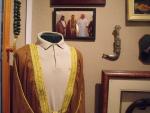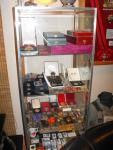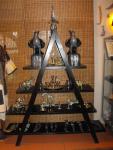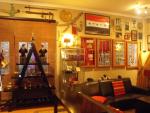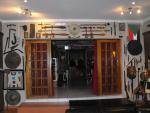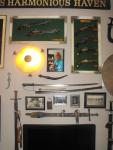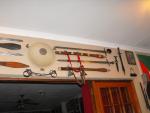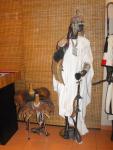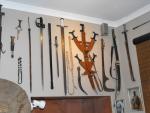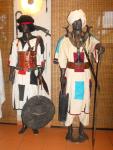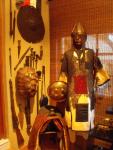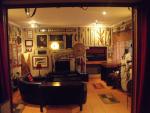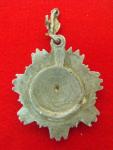
sabrigade
For Deletion-
Posts
1,707 -
Joined
-
Last visited
-
Days Won
34
Content Type
Profiles
Forums
Blogs
Gallery
Events
Store
Everything posted by sabrigade
-
The Endley Collection : Part 1 : The Sudan and Iraq
sabrigade replied to sabrigade's topic in Middle East & Arab States
-
The Endley Collection : Part 1 : The Sudan and Iraq
sabrigade replied to sabrigade's topic in Middle East & Arab States
A showcase with various medals, medallions and cases for medals and orders. Some medals are also from Kuwait and Syria. -
The Endley Collection : Part 1 : The Sudan and Iraq
sabrigade replied to sabrigade's topic in Middle East & Arab States
The ornaments and daggers were presented to me by my local staff when I left Iraq after working there for three years. -
The Endley Collection : Part 1 : The Sudan and Iraq
sabrigade replied to sabrigade's topic in Middle East & Arab States
The Iraqi part of the room. I have posted detail regarding some of the medals in other posts so will only provide an overview of my Iraqi collection. -
The Endley Collection : Part 1 : The Sudan and Iraq
sabrigade replied to sabrigade's topic in Middle East & Arab States
The back drop of the Sudanese collection which then leads on to my WW1 room which will be the second part of my postings. -
The Endley Collection : Part 1 : The Sudan and Iraq
sabrigade replied to sabrigade's topic in Middle East & Arab States
Many foreign weapons were captured by the Sudanese forces on battlefields where they defeated their enemies. The sword hanging close to the light is of European origin but I have not been able to positively identify it. The sword below it is a battlefield pickup from Omdurman. -
The Endley Collection : Part 1 : The Sudan and Iraq
sabrigade replied to sabrigade's topic in Middle East & Arab States
Another view of the various kaskara swords. I am no expert on these swords but have learnt that the blades were imported from Europe and the hilts and scabbards manufactured locally in Omdurman. A set of chains can also be seen that were used to shackle prisoners. Some of the swords have very ornate inscriptions on the blades and the handles are manufactured from leather or animal hides such as crocodile skin. -
The Endley Collection : Part 1 : The Sudan and Iraq
sabrigade replied to sabrigade's topic in Middle East & Arab States
In the background of the two warriors, variations of shields, swords, daggers and throwing sticks can be seen. Even though these weapons were primitive or basic, the wounds that were caused by them were horrendous. -
The Endley Collection : Part 1 : The Sudan and Iraq
sabrigade replied to sabrigade's topic in Middle East & Arab States
This mannequin depicts a female warrior of the time. It has been stated that women and children often joined battle as well. She carries a shield with the words " God is great' painted on it. The clothes and helmet she is wearing are original. Her sword or Kaskara is bound with silver and is a very ornate example. On her right hand side is a camel saddle that has seen a lot of use. -
The Endley Collection : Part 1 : The Sudan and Iraq
sabrigade replied to sabrigade's topic in Middle East & Arab States
-
The Endley Collection : Part 1 : The Sudan and Iraq
sabrigade replied to sabrigade's topic in Middle East & Arab States
The two mannequins depict two Sudanese warriors with their equipment and accessories as was used by Sudanese forces during the time of both the Mahdi and Khallifa. The figure on the left carries a trombash or throwing stick while his main weapon remains his kaskara sword. He has improvised leather armour around his middle. This is the so-called Dervish as portrayed by Kipling. The figure on the right is a leader or emir. He carries a water bottle and is armed with a sword and shorter length barbed spear. The dagger combination is very interestingly part of a combination where a young crocodile was used as a scabbard. Both wear hejabs, these contained messages from the Khoran. The warrior on the left wears his as a belt and the emir uses his a necklace. They are wearing jibbahs which became the "uniform" of the Mahdi army. The jibbah on the right is very ornate and depicts the status of the emir. These jibbahs were made for me by a tailor in Omdurman who still does his work on old machines and with skills that were passed on through the generations. -
The Endley Collection : Part 1 : The Sudan and Iraq
sabrigade replied to sabrigade's topic in Middle East & Arab States
I am in the process of completing the ORBAT for the British/Egyptian Forces that fought at the battle of Omdurman in badges. The Queen's Sudan medal pair is to a private in the Lincolnshire Regiment who fought at Omdurman and also at Atbara. -
The Endley Collection : Part 1 : The Sudan and Iraq
sabrigade replied to sabrigade's topic in Middle East & Arab States
This corner display contains a suit of armour that was used by Sudanese forces at the battle of Omdurman. I purchased it from the owner's grandson in Khartoum. He carries a dhahl shield which is from Indian origin. The saddle is typical of the type used by Sudanese cavalry of the period. The tortoise shell configuration was designed to be used as a shield and contained the main kaskara sword as well as the daggers. The Martini carbine is de-activated and is a firearm that was used during the period of the re-conquest of the Sudan. Various spear heads and a battle-axe can also be seen. The jibbah he is wearing is the padded variety and was made for me by a tailor in Omdurman. -
The Endley Collection : Part 1 : The Sudan and Iraq
sabrigade replied to sabrigade's topic in Middle East & Arab States
This portrays most of the medals that I have acquired here in the Sudan. It includes two gordon star's for the siege of Khartoum. There are also examples of the coins that were struck by the Mahdi in Omdurman before his death. The two table knives have Victorian markings on them. -
I will be posting in four parts starting with the Sudan and Iraq where I have worked during the past 5 years. Each part of the collection is housed and maintained in a different room in my house. I have been collecting militaria for more than 30 years now.This is the entrance to the television room in which this part of my collection is housed. The room is named after my late father.
-
Nice little South African pair
sabrigade replied to Colin Davie's topic in Great Britain: Orders, Gallantry, Campaign Medals
Chris, Thank you for a very enlightening response, now I understand the SA singles in my collection, mostly to the Cape Garrisson Artillery! -
Small wars in Africa...
sabrigade replied to Chris Boonzaier's topic in Great Britain: Orders, Gallantry, Campaign Medals
http://gmic.co.uk/uploads/monthly_02_2009/post-3034-1233642557.jpghttp://gmic.co.uk/uploads/monthly_02_2009/post-3034-1233642584.jpg http://gmic.co.uk/uploads/monthly_02_2009/post-3034-1233642606.jpghttp://gmic.co.uk/uploads/monthly_02_2009/post-3034-1233642628.jpg I purchased this medal in the Omdurman Souk last year. Mongalla is a very small town close to the capital of Southern Sudan which is called Juba. This medal is the variation with the George 5th obverse which is supposedly rare according to the limited sources I have availble here in the Sudan. This clasp was awarded for military operations in the vicinity of the southern Sudanese borders and took place west of Lake Rudolph. These operations were against the Northern Turkhana, Marille, Donyiro and other tribes. Approximately 10 members of the Mongalla Police, of which this recipient was one, were awarded this medal and clasp. -
Sheikh Abed Rahman Alichatim Studio Photograph
sabrigade replied to sabrigade's topic in Middle East & Arab States
That would be very helpfull. I was given the photograph by a dealer in the Omdurman Souk and he provided the name. I am currently in Khartoum. -
Leigh, The numbers of the arabic numerals in english are " 3343-9". I think the 9th Sudanese Infantry is correct and also applicable in this instance. I have limited research resources with me in the Sudan but this is what I have also come up with after referring to British Battles and Medals, the 1971 fourth edition. The 9th Sudanese Infantry participated in all these engagements.
-
Thanks Michael, I have "DHLed" the medals back home, will ask wife to take more photographs including the number of the recipient. He obviously took part in all the battles against the Mahdi and the Khallifa.
-
Ed, Yes, as far as my knowledge goes. I have met a Sudanese Historian who has assisted me in obtaining these medals and some others which I will post sometime. According to him, these Force numbers can be researched. I will use this example as an experiment and will see what I can find out. He has a private museum in Khartoum which is very interesting, if there is interest I will ask his permission to post photographs. Regards, Will
-
Michael, Arabic numerals!
-
Hi Chris, There we go! I am currently in Southern Sudan so " binge" posting while I am on the Internet! Regards, Will
-
-

